Understanding Cybersecurity
Cybersecurity is the practice of protecting internet-connected systems, including hardware, software, and data, from cyberattacks. It’s essential to protect personal and financial information from unauthorized access. Cyber threats are evolving, and understanding them is key to staying safe online.
The types of cyber threats include malware, phishing, and ransomware. Malware comprises harmful software designed to damage or disable computers. Examples are viruses, worms, and trojan horses. Phishing involves tricking individuals into divulging personal information through deceptive emails or websites. Ransomware locks users out of their devices or files until they pay a ransom.
Adopting essential cybersecurity measures can prevent many online risks. Using strong, unique passwords for each account minimizes the risk. A password manager can help create and store complex passwords. Two-factor authentication (2FA) adds an extra layer of security.
Regular software updates are crucial. They patch vulnerabilities that hackers exploit. Antivirus software also detects and removes malicious programs, protecting your device from infections. Firewalls block unauthorized access to your computer, acting as a barrier between your device and potential intruders.
Public Wi-Fi networks pose significant risks. They often lack encryption, making it easier for hackers to intercept data. When using public Wi-Fi, avoid accessing sensitive information. A Virtual Private Network (VPN) encrypts your internet connection, providing a secure browsing experience.
Awareness and education are vital components of cybersecurity. Familiarizing yourself with common online threats and safe practices can significantly reduce your risk. Online courses and tutorials offer valuable insights into maintaining secure digital habits.
Incorporating these cybersecurity practices reduces the likelihood of falling victim to cyberattacks. Stay informed about the latest cyber threats and adopt proactive measures to protect your digital life.
Common Online Threats
Understanding common online threats is crucial for safeguarding your personal information. Below, I’ll cover some of the most prevalent cyber threats.
Viruses and Malware
Viruses and malware pose significant risks to your digital security. Malware, which includes viruses, worms, and trojans, can infiltrate your system through email attachments, malicious websites, or software downloads. Once in your system, malware can steal personal data, monitor your activities, or damage your files. For example, a trojan might masquerade as legitimate software, tricking you into installing it.
Phishing Attacks
Phishing attacks aim to trick you into revealing sensitive information like login credentials and credit card numbers. These attacks often come through emails that appear to be from reputable sources, urging you to click a link or download an attachment. Phishers can replicate official-looking emails from banks, social media platforms, or online services. If you enter your details, attackers can use them for identity theft or financial fraud.
Ransomware
Ransomware encrypts your files and demands payment to unlock them. It typically spreads through infected email attachments or compromised websites. Once executed, ransomware can lock you out of important files, demanding ransom, often in cryptocurrency, to restore access. For example, the WannaCry ransomware attack in 2017 affected numerous organizations worldwide, causing substantial data loss and financial damage.
Understanding these threats helps you take proactive steps to protect yourself online.
Best Practices for Online Security

Implementing best practices is crucial to enhancing online security and safeguarding personal and professional data.
Strong Passwords
Using strong passwords is fundamental for online security. A robust password combines uppercase and lowercase letters, numbers, and special characters, extending to at least 12 characters. Avoid using common words or predictable patterns. For instance, instead of using “Password123”, create a unique combination like “Qz!8mT9kP&4w”. Password managers can help generate and store complex passwords securely.
Two-Factor Authentication
Two-factor authentication (2FA) adds a layer of security by requiring a second verification step. In addition to the password, 2FA often requires a code sent to your mobile device or an authentication app. This makes unauthorized access significantly harder, even if someone knows your password. Enable 2FA on all accounts that support it, particularly email, banking, and social media.
Regular Software Updates
- Regularly updating software protects against vulnerabilities that cybercriminals exploit.
- Software updates often include patches for security flaws.
- Set your operating system, applications, and antivirus programs to update automatically.
- Consistently using the latest versions reduces the risk of malware infections and other security breaches.
- Implementing these best practices strengthens online security, making it more challenging for cybercriminals to compromise your accounts and data.
Securing Personal Devices
Understanding how to secure personal devices is vital for protecting online identities and data. It’s crucial to employ several security measures to mitigate risks.
Antivirus Software
Antivirus software is essential for detecting and removing malicious programs from devices. This software identifies a wide range of threats, including viruses, malware, and spyware. Regularly updating the antivirus software ensures it can recognize and neutralize the latest threats. Well-known antivirus programs, such as:
- Norton
- McAfee
- Bitdefender
offer robust protection features and frequent updates. Using a reputable antivirus solution can prevent unauthorized access, data breaches, and system damage.
Firewalls
Firewalls act as a barrier between personal devices and potentially harmful external networks. By filtering incoming and outgoing traffic, firewalls block unauthorized access while allowing legitimate communication. Both hardware and software firewalls offer layers of defense. I recommend enabling the built-in firewall on operating systems such as Windows and macOS, and considering third-party options like ZoneAlarm for enhanced security. Properly configured firewalls prevent cybercriminals from exploiting vulnerabilities and gaining access to sensitive information.
Safe Browsing Habits
Navigating the internet securely requires adopting certain habits to minimize risks. Developing these practices helps safeguard personal information and ensures a safer online experience.
Recognizing Secure Websites
Identifying secure websites is crucial for protecting sensitive data. Secure sites use HTTPS, not HTTP, in their URLs. I look for a padlock icon left of the web address because it indicates encryption of data shared between the browser and server. Trusted websites also have valid SSL (Secure Sockets Layer) certificates, which I verify by clicking the padlock icon and reviewing the certificate details.
Avoiding Suspicious Links
Staying away from suspicious links is essential to prevent malware and phishing attacks. I avoid clicking on links in unsolicited emails or messages. Hovering over links reveals their true destination, helping me decide if they are safe. Shortened URLs might hide malicious sites, so I use link expander tools to check their legitimacy before clicking.
Protecting Sensitive Information
Sensitive information must be guarded against online threats. By using encryption and secure cloud storage, data can be kept safe.
Data Encryption
Encrypting data ensures that only authorized parties can access it. Encryption converts readable data into coded text, which only someone with the correct decryption key can decipher. This method is crucial for protecting sensitive information such as financial data, personal identifiers, and confidential communications. Tools like BitLocker for Windows and FileVault for macOS can encrypt entire hard drives, adding an extra layer of security to personal devices. Encrypting emails and attachments is also vital, with services like PGP (Pretty Good Privacy) providing end-to-end encryption for secure communication.
Secure Cloud Storage
Storing data in the cloud offers convenience, but it comes with risks if not properly managed. Secure cloud storage solutions encrypt data both at rest and in transit, ensuring that it remains protected when stored and during uploads and downloads. Using reputable cloud services like Google Drive, Dropbox, or iCloud, known for robust security practices, provides an added layer of trust. It’s essential to use strong passwords and enable two-factor authentication for cloud accounts to prevent unauthorized access. Regularly reviewing and updating security settings on cloud storage accounts can further enhance data protection.


 Amelie Glover played a pivotal role in shaping the success of News Flip Network through her expertise and dedication. With a keen eye for detail, she focused on ensuring the platform’s content flows smoothly, making it both engaging and informative. Glover’s efforts in organizing the site’s structure and managing editorial tasks helped create a seamless user experience, enhancing the accessibility of news for readers around the world.
Amelie Glover played a pivotal role in shaping the success of News Flip Network through her expertise and dedication. With a keen eye for detail, she focused on ensuring the platform’s content flows smoothly, making it both engaging and informative. Glover’s efforts in organizing the site’s structure and managing editorial tasks helped create a seamless user experience, enhancing the accessibility of news for readers around the world.